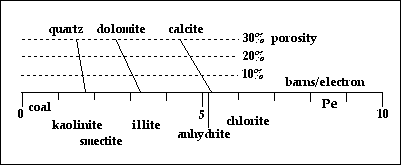

The photoelectric index (Pe) is a supplementary measurement by the latest generation of density logging tools, and records the absorption of low-energy gamma rays by the formation in units of barns per electron. The logged value is a direct function of the aggregate atomic number (Z) of the elements in the formation, and so is a sensitive indicator of mineralogy. The values are less sensitive to pore volume changes than either the neutron or density logs, so that the index is an excellent indicator of mineralogy. The common reservoir mineral reference values are : quartz 1.81 ; dolomite 3.14 ; calcite 5.08 barns/electron. The photoelectric index log is commonly scaled on a range between 0 and 10 barns/electron, and a generalized interpretation guide is given in the figure. The variable compositions of clay minerals means that their position on the scale should only be taken as a broad indication. The ordering of clay minerals on the index is almost entirely a function of their likely content of iron.
The photoelectric index log is particularly useful when considered in conjunction with the neutron/density porosity overlay as an additional input to resolve mixtures of minerals such as commonly occur in "complex carbonates" as cherty dolomitic limestones or anhydritic dolomites. Successful interpretation requires the disposition of the neutron/density porosity traces to be considered simultaneously with the Pe curve. The photoelectric factor curve should be watched most carefully, because it has a finer vertical resolution (about half a foot) than the neutron/density curves (about 2 feet). As a result, the Pe character can give a better reading on lithology in thin beds, where the averaging effect of adjacent thick beds may smooth the neutron and density responses adversely.